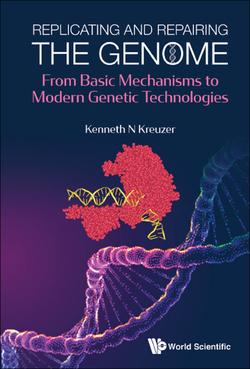Читать книгу Replicating And Repairing The Genome: From Basic Mechanisms To Modern Genetic Technologies - Kenneth N Kreuzer - Страница 28
На сайте Литреса книга снята с продажи.
How did they test that?
Are leading- and lagging-strand synthesis coupled?
ОглавлениеLee, Chastain, Kusakabe, Griffith, and Richardson (1998) exploited a powerful “minicircle” assay and the DNA replication system of bacteriophage T7. The minicircle, constructed with chemically synthesized oligonucleotides, consists of a 70-bp circle with a 5′-single-stranded extension (panel A). The 3′ end at the branch point serves as the site for initiation of leading-strand synthesis, while lagging-strand synthesis initiates when primase sites are exposed during the first round of leading-strand synthesis. The substrate is replicated efficiently (panel B), producing duplex products that can exceed 20,000 bp (hundreds of times around the circle). A key feature is that the two strands differ greatly in nucleotide content — the leading-strand product contains a great excess of dG over dC residues, while the lagging-strand product is just the opposite (the only exception is from the primase sites that needed to be present). This sequence arrangement is useful for two reasons. First, synthesis of the two strands can be measured separately: about 95% of label from radioactive dGTP goes into the leading strand, while 95% of label from radioactive dCTP goes into the lagging strand. Second, synthesis on the two strands can be specifically inhibited with different chain-terminating nucleotides. For example, dideoxy CTP (ddCTP; structure shown in panel C) would be incorporated 20-fold more frequently into the lagging-strand product than the leading-strand product, and thereby preferentially inhibit lagging-strand synthesis.
In this experiment, DNA replication is monitored with either radioactive dCTP (panel D, left graph; lagging-strand synthesis) or radioactive dGTP (right graph; leading-strand synthesis). After 2.5 minutes of the reaction, ddCTP (non-radioactive) is added to inhibit lagging-strand synthesis. Note that the chain-terminating nucleotide is added at an 80-fold lower concentration than normal dCTP, and so the chain terminator is only incorporated in a small fraction of extensions opposite dG residues. The striking result is that ddCTP addition rapidly inhibits both leading- and lagging-strand synthesis at roughly equal efficiencies. Evidently, the leading-strand polymerase is somehow induced to stop synthesis when its lagging-strand partner in the replisome is obstructed.
Panels A and D in this Figure were reproduced from Lee et al. (1998), with permission from Elsevier; permission conveyed by Copyright Clearance Center, Inc.
1Bacterial thioredoxin is also involved in assembly of certain bacteriophages, and again, the redox function of the protein is not required. Thioredoxin has been found to bind some 80 different bacterial proteins, suggesting that it may be involved as a structural component in additional processes.
2Thioredoxin also plays a key role here, configuring the DNA polymerase so it can bind the second site on the helicase/primase.
3These names are arbitrary, in that the six subunits are identical, but help in explaining the subunit behavior during helicase movement along the DNA.
4The third DNA polymerase visualized in these studies is bound to a different site in the helicase/primase complex than the secondary site discussed in Section 2.3; thus, a total of at least four potential DNA polymerase binding sites are involved in replication of T7 DNA.
5A number of animated videos of the trombone model can be found online, including those at www.youtube.com.
6Called gp6 for the aficionado.
7Called gp1.3.
